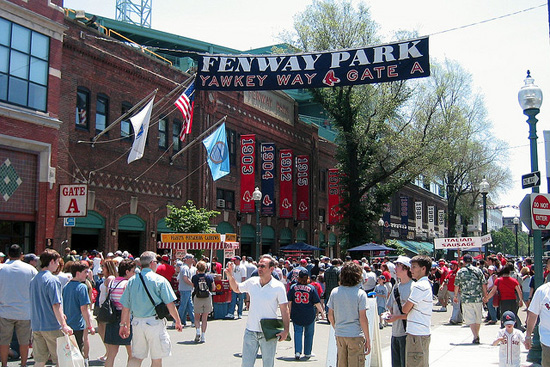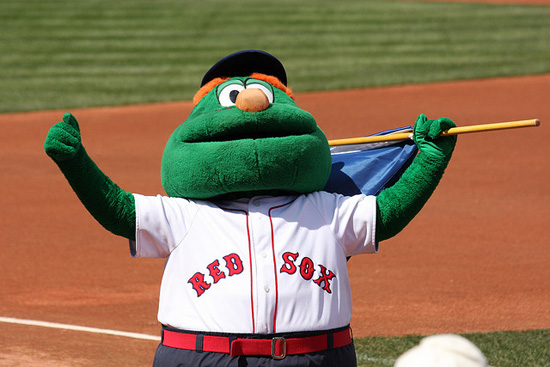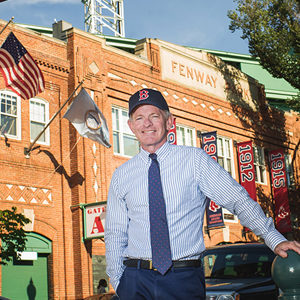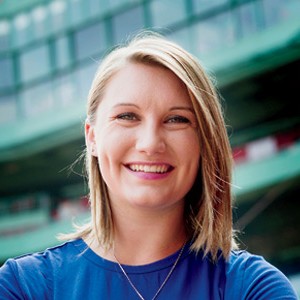A major league sports team—of any sport—wins a national championship or a division title. Within minutes of the final out, the final whistle, or the final buzzer, as the triumphant players whoop and hug, someone from the front office hands them hats or T-shirts, or both, emblazoned with the team logo and trumpeting their victory: “2013 Conference Champions,” for instance.
Those hats and shirts (for sale in stores the next day) are as much a part of professional sports as hot dogs and call-in radio. If you’re under 40 years old, you’ve witnessed this postgame routine since you were a kid. If you’re over 40, you’ve seen it so long that you might wonder when it started. And furthermore, who came up with the idea?
The answers: 1986 and Larry Cancro. The Boston Red Sox had just clinched the American League East division, and team marketing guru Cancro (CAS’77) took to the field and passed out commemorative T-shirts to teammates Jim Rice, Dwight Evans, and the rest. The players were bewildered at first. When they went on to win the league championship, they were not so surprised to receive more shirts.
A final round of T-shirts was printed for the Sox that year—World Series champs—but as longtime fans know, that team never got the chance to wear them.
“When the ball went through Buckner’s legs,” says Cancro, “I was in the clubhouse putting shirts on everyone’s chair—and then I had to whip them off. In about 15 seconds, whoosh.” Cancro, the shirts, reporters, cameramen, the trophy, and the champagne all disappeared through a back door.
By the time the Red Sox won a World Series trophy, in 2004, the practice was de rigueur across the sports world—just like the mail-order team merchandise business, another concept that sprang from the mind of Cancro, when he was with the Atlanta Braves in the early 1980s. In his 35 years in baseball—28 of them with the Red Sox—Cancro has thought up all sorts of fun and entertainment that fans now regard as tradition, from Wally the Green Monster to the block-party-style closure of Yawkey Way on game days to the rock concerts Fenway Park hosts on off days. Currently the club’s senior vice president for Fenway affairs, Cancro has also put his creative and organizational skills into charitable efforts, such as the nonprofit advocacy group Autism Speaks.
And pivotal to his unusual career was his time at Boston University—a place, Cancro says, that in some ways he never left.
Free to dabble

Under Cancro’s tenure, Yawkey Way is now transformed into a pedestrian block party on game days. Photo courtesy of Flickr contributor Wally Gobetz
Cancro grew up in Westchester County, N.Y., but had always wanted to work for the Red Sox. He had all but decided to attend BU when his parents took him to visit campus.
“We parked in Kenmore Square, in front of Nemo’s sub shop,” he recalls. “We got out of the car, and I looked up and saw stadium lights. I stopped somebody walking by and said, ‘Hey, is that Fenway Park?’ The guy said, ‘Yeah.’ And I turned to my parents and said, ‘I’m going here.’
“I ended up in a dorm from which I could see the ballpark—and from my office today, I can see my old dorms. So I haven’t traveled too far since that day, really.”
Cancro majored in psychology, but he didn’t want to be a psychologist like his father. “I had some interest in it, but I had a lot more in sports, in writing, in business, and I had always studied ballparks and crowds and crowd patterns and promotional techniques. I wanted a job in that somehow, and people would say, ‘That job doesn’t exist.’ Because at the time, that job didn’t exist.”
But he had come to the right place. “What was great for me about BU,” he says, was that “I could dabble in all of that.” He interned in psychology, working with developmentally challenged kids. He worked for the athletics department and covered the men’s ice hockey team for the Daily Free Press. “And I used these things to help me train for my chosen profession,” he says. BU was, and is, “a very diverse campus, and you’re encouraged to go pursue the thought process that you have. So I dreamed up a career for myself, and then created it.”
Cancro started his career in the minors, in the sales office of the Eastern League’s Jersey Indians, before the Braves hired him in 1979. The concept of selling licensed team jerseys to fans, even at the ballpark, was relatively new when the idea of selling them to fans around the world through a mail-order catalog hit Cancro.
In the pre-internet days, this endeavor was by no means guaranteed to succeed. “Honestly, the pro forma was for it to fail,” Cancro says. But the business took off, and other teams took notice. And the Red Sox took notice of Cancro, recruiting him to work in marketing and sales at Fenway. In 1985, he and his wife, Luise, moved back to Boston, where they wanted to be. “Trying to follow BU hockey from Georgia was too difficult,” he says.
Inventing another kind of Green Monster

Another of Cancro’s innovations: Wally, the Red Sox mascot. Photo by Flickr contributor Nedster78
With his track record of coming up with good ideas (such as the division-title T-shirts), Cancro was well positioned to rise when John Henry (Hon.’05) bought the club in 2002 and proved willing to take risks (like hiring 28-year-old general manager Theo Epstein). Whereas the previous owner had talked of replacing the “lyric little bandbox,” as John Updike described Fenway Park in The New Yorker, with a larger-capacity stadium, Henry was committed to keeping the team in the existing park, built in 1912. That meant finding more creative ways of raising revenues, and it was Cancro who worked closely with the team’s architect to add seats in surprising places, such as the top of the Green Monster, the high wall in left field.
Cancro also invented another kind of Green Monster, one named Wally, who is now the Sox mascot. “Some people were skeptical,” he says, “but the idea was to create a vehicle to teach young people the history of Fenway Park and to help pass along the passion that all of us here in New England have for the Red Sox. That’s what is so special about what we have here: it’s a multigenerational thing.” Fenway Park is New Englanders’ common gathering place, where people of all ages and varieties share “a special camaraderie,” Cancro says. “That’s a good thing.”
Wally, the wall seats, the Yawkey Way block party atmosphere—all are part of embracing the strengths of a brand with tradition, while not shying away from change. Another novel Cancro brainchild was initiating rock concerts at Fenway. Cancro sought out friend and major concert promoter Don Law (CAS’68), with whom he’s been going to Terrier hockey games since the 1980s, and got the ball rolling with a two-night Bruce Springsteen stand in 2003. Since then, he’s booked stars from Jimmy Buffett to the Dropkick Murphys.
Cancro’s Red Sox and BU connections have helped immeasurably in his volunteer work for a cause dear to him, autism research. (One of his daughters is autistic.) He serves as president of the New England chapter of Autism Speaks, hosting fundraisers and donating proceeds to autism researchers at the College of Arts & Sciences and the School of Medicine, as well as elsewhere. At the first dinner Cancro held, BU’s four 1980 ice hockey Olympic gold medalists showed up unannounced. “That speaks to the quality of the type of people that I met at BU during those years,” he says warmly.
Cancro sees his volunteer work as an extension of his profession. “I couldn’t have achieved what I have with Autism Speaks without the backing of the Red Sox and the BU hockey team. I’ve learned that you can do so much good for people with something as simple as a game. Sometimes people who need uplifting are just uplifted. And when you figure that out, it’s very rewarding.”
A version of this story was originally published in the spring 2013 edition of Arts & Sciences.


















































Great story, even for a Yankee fan.
I’ve had the privilege of knowing Larry Cancro since shortly after he joined the Red Sox in 1985. He’s a true professional and a class act. I wish him and the Red Sox continued success.
Hank Shafran
COM ’68
The designation for Mr. Cancro in this article as CAS’ 77 is factually inaccurate. In 1977 there was no school with the name “College of Arts and Sciences” (CAS) at Boston University. Mr. Cancro attended the College of Liberal Arts (CLA). The name change did not take place until the mid 1990s. The correct designation for Mr. Cancro is CLA’ 77.